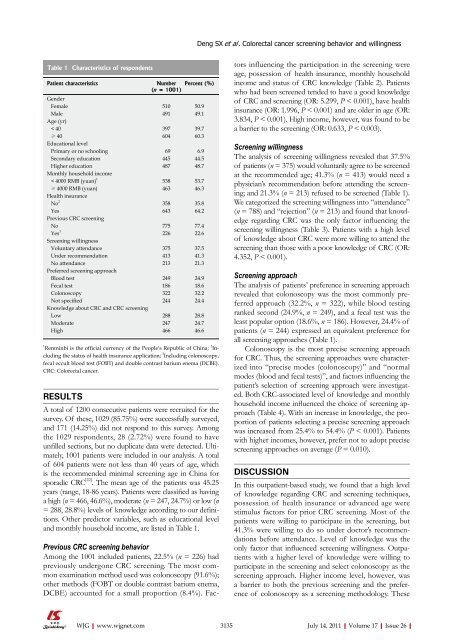26 - World Journal of Gastroenterology
26 - World Journal of Gastroenterology
26 - World Journal of Gastroenterology
Create successful ePaper yourself
Turn your PDF publications into a flip-book with our unique Google optimized e-Paper software.
Table 1 Characteristics <strong>of</strong> respondents<br />
Patient characteristics Number<br />
(n = 1001)<br />
Percent (%)<br />
Gender<br />
Female 510 50.9<br />
Male<br />
Age (yr)<br />
491 49.1<br />
< 40 397 39.7<br />
≥ 40<br />
Educational level<br />
604 60.3<br />
Primary or no schooling 69 6.9<br />
Secondary education 445 44.5<br />
Higher education<br />
Monthly household income<br />
487 48.7<br />
< 4000 RMB (yuan) 1<br />
538 53.7<br />
≥ 4000 RMB (yuan)<br />
Health insurance<br />
463 46.3<br />
No 2<br />
358 35.8<br />
Yes<br />
Previous CRC screening<br />
643 64.2<br />
No 775 77.4<br />
Yes 3<br />
Screening willingness<br />
2<strong>26</strong> 22.6<br />
Voluntary attendance 375 37.5<br />
Under recommendation 413 41.3<br />
No attendance<br />
Preferred screening approach<br />
213 21.3<br />
Blood test 249 24.9<br />
Fecal test 186 18.6<br />
Colonoscopy 322 32.2<br />
Not specified<br />
Knowledge about CRC and CRC screening<br />
244 24.4<br />
Low 288 28.8<br />
Moderate 247 24.7<br />
High 466 46.6<br />
1 Renminbi is the <strong>of</strong>ficial currency <strong>of</strong> the People's Republic <strong>of</strong> China; 2 Including<br />
the status <strong>of</strong> health insurance application; 3 Including colonoscopy,<br />
fecal occult blood test (FOBT) and double contrast barium enema (DCBE).<br />
CRC: Colorectal cancer.<br />
RESULTS<br />
A total <strong>of</strong> 1200 consecutive patients were recruited for the<br />
survey. Of these, 1029 (85.75%) were successfully surveyed,<br />
and 171 (14.25%) did not respond to this survey. Among<br />
the 1029 respondents, 28 (2.72%) were found to have<br />
unfilled sections, but no duplicate data were detected. Ultimately,<br />
1001 patients were included in our analysis. A total<br />
<strong>of</strong> 604 patients were not less than 40 years <strong>of</strong> age, which<br />
is the recommended minimal screening age in China for<br />
sporadic CRC [22] . The mean age <strong>of</strong> the patients was 45.25<br />
years (range, 18-86 years). Patients were classified as having<br />
a high (n = 466, 46.6%), moderate (n = 247, 24.7%) or low (n<br />
= 288, 28.8%) levels <strong>of</strong> knowledge according to our definitions.<br />
Other predictor variables, such as educational level<br />
and monthly household income, are listed in Table 1.<br />
Previous CRC screening behavior<br />
Among the 1001 included patients, 22.5% (n = 2<strong>26</strong>) had<br />
previously undergone CRC screening. The most common<br />
examination method used was colonoscopy (91.6%);<br />
other methods (FOBT or double contrast barium enema,<br />
DCBE) accounted for a small proportion (8.4%). Fac-<br />
WJG|www.wjgnet.com<br />
Deng SX et al . Colorectal cancer screening behavior and willingness<br />
tors influencing the participation in the screening were<br />
age, possession <strong>of</strong> health insurance, monthly household<br />
income and status <strong>of</strong> CRC knowledge (Table 2). Patients<br />
who had been screened tended to have a good knowledge<br />
<strong>of</strong> CRC and screening (OR: 5.299, P < 0.001), have health<br />
insurance (OR: 1.996, P < 0.001) and are older in age (OR:<br />
3.834, P < 0.001). High income, however, was found to be<br />
a barrier to the screening (OR: 0.633, P < 0.003).<br />
Screening willingness<br />
The analysis <strong>of</strong> screening willingness revealed that 37.5%<br />
<strong>of</strong> patients (n = 375) would voluntarily agree to be screened<br />
at the recommended age; 41.3% (n = 413) would need a<br />
physician’s recommendation before attending the screening;<br />
and 21.3% (n = 213) refused to be screened (Table 1).<br />
We categorized the screening willingness into “attendance”<br />
(n = 788) and “rejection” (n = 213) and found that knowledge<br />
regarding CRC was the only factor influencing the<br />
screening willingness (Table 3). Patients with a high level<br />
<strong>of</strong> knowledge about CRC were more willing to attend the<br />
screening than those with a poor knowledge <strong>of</strong> CRC (OR:<br />
4.352, P < 0.001).<br />
Screening approach<br />
The analysis <strong>of</strong> patients’ preference in screening approach<br />
revealed that colonoscopy was the most commonly preferred<br />
approach (32.2%, n = 322), while blood testing<br />
ranked second (24.9%, n = 249), and a fecal test was the<br />
least popular option (18.6%, n = 186). However, 24.4% <strong>of</strong><br />
patients (n = 244) expressed an equivalent preference for<br />
all screening approaches (Table 1).<br />
Colonoscopy is the most precise screening approach<br />
for CRC. Thus, the screening approaches were characterized<br />
into “precise modes (colonoscopy)” and “normal<br />
modes (blood and fecal tests)”, and factors influencing the<br />
patient’s selection <strong>of</strong> screening approach were investigated.<br />
Both CRC-associated level <strong>of</strong> knowledge and monthly<br />
household income influenced the choice <strong>of</strong> screening approach<br />
(Table 4). With an increase in knowledge, the proportion<br />
<strong>of</strong> patients selecting a precise screening approach<br />
was increased from 25.4% to 54.4% (P < 0.001). Patients<br />
with higher incomes, however, prefer not to adopt precise<br />
screening approaches on average (P = 0.010).<br />
DISCUSSION<br />
In this outpatient-based study, we found that a high level<br />
<strong>of</strong> knowledge regarding CRC and screening techniques,<br />
possession <strong>of</strong> health insurance or advanced age were<br />
stimulus factors for prior CRC screening. Most <strong>of</strong> the<br />
patients were willing to participate in the screening, but<br />
41.3% were willing to do so under doctor’s recommendations<br />
before attendance. Level <strong>of</strong> knowledge was the<br />
only factor that influenced screening willingness. Outpatients<br />
with a higher level <strong>of</strong> knowledge were willing to<br />
participate in the screening and select colonoscopy as the<br />
screening approach. Higher income level, however, was<br />
a barrier to both the previous screening and the preference<br />
<strong>of</strong> colonoscopy as a screening methodology. These<br />
3135 July 14, 2011|Volume 17|Issue <strong>26</strong>|

















